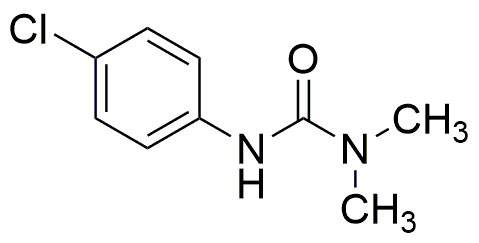3-(4-Chlorophenyl)-1,1-dimethylurea is widely utilized in research focused on:
- Agricultural Chemistry: This compound acts as a herbicide, effectively controlling weed growth in various crops, thus enhancing agricultural productivity.
- Pharmaceutical Development: It serves as a key intermediate in the synthesis of pharmaceuticals, particularly in the development of anti-inflammatory and analgesic drugs.
- Environmental Studies: Researchers use it to study the degradation of chemical compounds in soil and water, helping to assess environmental impact and safety.
- Analytical Chemistry: It is employed in analytical methods for detecting and quantifying pesticide residues, ensuring food safety and compliance with regulations.
- Biochemical Research: The compound is utilized in studies related to enzyme inhibition, providing insights into metabolic pathways and potential therapeutic targets.
Información general
Propiedades
Seguridad y normativas
Aplicaciones
3-(4-Chlorophenyl)-1,1-dimethylurea is widely utilized in research focused on:
- Agricultural Chemistry: This compound acts as a herbicide, effectively controlling weed growth in various crops, thus enhancing agricultural productivity.
- Pharmaceutical Development: It serves as a key intermediate in the synthesis of pharmaceuticals, particularly in the development of anti-inflammatory and analgesic drugs.
- Environmental Studies: Researchers use it to study the degradation of chemical compounds in soil and water, helping to assess environmental impact and safety.
- Analytical Chemistry: It is employed in analytical methods for detecting and quantifying pesticide residues, ensuring food safety and compliance with regulations.
- Biochemical Research: The compound is utilized in studies related to enzyme inhibition, providing insights into metabolic pathways and potential therapeutic targets.
Documentos
Hojas de datos de seguridad (HDS)
La SDS proporciona información de seguridad completa sobre la manipulación, el almacenamiento y la eliminación del producto.
Especificación del producto (PS)
La PS proporciona un desglose completo de las propiedades del producto, incluida la composición química, el estado físico, la pureza y los requisitos de almacenamiento. También detalla los rangos de calidad aceptables y las aplicaciones previstas del producto.
Certificados de análisis (COA)
Busque certificados de análisis (COA) ingresando el número de lote del producto. Los números de lote y de partida se pueden encontrar en la etiqueta de un producto después de las palabras "Lote" o "Lote".
Número de catálogo
Número de lote/lote
Certificados de origen (COO)
Este certificado de origen confirma el país en el que se fabricó el producto y también detalla los materiales y componentes utilizados en él y si se deriva de fuentes naturales, sintéticas u otras fuentes específicas. Este certificado puede ser necesario para cumplir con las normativas aduaneras, comerciales y regulatorias.
Número de catálogo
Número de lote/lote
Hojas de datos de seguridad (HDS)
La SDS proporciona información de seguridad completa sobre la manipulación, el almacenamiento y la eliminación del producto.
DownloadEspecificación del producto (PS)
La PS proporciona un desglose completo de las propiedades del producto, incluida la composición química, el estado físico, la pureza y los requisitos de almacenamiento. También detalla los rangos de calidad aceptables y las aplicaciones previstas del producto.
DownloadCertificados de análisis (COA)
Busque certificados de análisis (COA) ingresando el número de lote del producto. Los números de lote y de partida se pueden encontrar en la etiqueta de un producto después de las palabras "Lote" o "Lote".
Número de catálogo
Número de lote/lote
Certificados de origen (COO)
Este certificado de origen confirma el país en el que se fabricó el producto y también detalla los materiales y componentes utilizados en él y si se deriva de fuentes naturales, sintéticas u otras fuentes específicas. Este certificado puede ser necesario para cumplir con las normativas aduaneras, comerciales y regulatorias.


